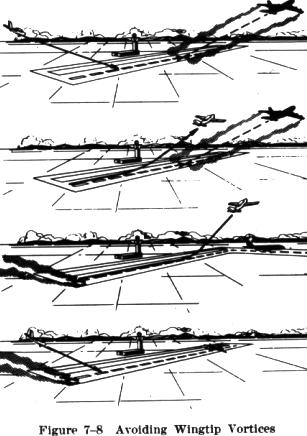Wake Turbulence Avoidance
Wake Turbulence Avoidance
Just as powered boats do on water, every airplane generates
a wake while in flight. Initially, the disturbance was attributed to "prop
wash." It is now known, however, that this disturbance is caused by a pair
of counter rotating vortices trailing from the airplane's wingtips. The
strong vortices from large aircraft pose particular problems to light aircraft.
In fact, the wingtip vortices of these large aircraft can impose rolling
moments that exceed the control capability of many light aircraft. The
manner in which this hazardous phenomenon is created is explained in the
chapter on Principles of Flight and Performance Characteristics.
| This invisible turbulence can be extremely dangerous when it is encountered
during takeoff and landing. Numerous airplanes have encountered wake turbulence
of such severity that complete loss of control of the airplane resulted.
The aircraft were, in some cases, at altitudes too low to recover. The
most severe wake turbulence is produced by large and heavy commercial or
military airplanes in the landing or takeoff configuration.
Under certain conditions, airport traffic controllers apply special
procedures for separating light aircraft from heavy jet aircraft. The controllers
also provide pilots with whom they are in communication, and who, in the
tower's opinion, may be adversely affected by wake turbulence from a large
airplane, the position and direction of flight of the large airplane followed
by the phrase "CAUTION - WAKE TURBULENCE." Whether or not a warning has
been given, however, THE PILOT IS EXPECTED TO ADJUST THE FLIGHTPATH AS
NECESSARY TO AVOID WAKE ENCOUNTERS.
Vortices are generated whenever an airplane is developing lift, since
trailing vortices are a byproduct of wing lift. Therefore, prior to takeoff
or landing, pilots should always note the rotation or touchdown point of
the preceding airplane (Fig. 7-8).
Pilots of all aircraft should visualize the location of the vortex
trail behind large aircraft and use proper vortex avoidance procedures
to achieve safe operation. The following vortex avoidance procedures are
recommended for the various situations. |
|
1. Landing behind a large airplane -
on the same runway. Stay at or above the large aircraft's approach flightpath
- note its touchdown point - then land beyond that point.
2. Landing behind a large airplane -
when a parallel runway is closer than 2,500 feet, consider possible drift
of the vortices to the other runway. Stay at or above the large airplane's
final approach path - note its touchdown point - then land beyond that
point.
3. Landing behind a large airplane -
on a crossing runway: cross above the large airplane's flightpath.
4. Landing behind a departing large airplane
- on the same runway. Note the large airplane's rotation point - then land
well prior to its rotation point.
5. Landing behind a departing large airplane
- on a crossing runway. Note the large airplane's rotation point - if it
is past the runway intersection - continue the approach but land prior
to the intersection, avoiding flight below the large airplane's flightpath.
Abandon the approach unless a landing is assured well before reaching the
intersection.
6. Departing behind a large airplane:
Note the large airplane's rotation point - then rotate prior to the large
airplane's rotation point and continue to climb above and stay upwind of
the large airplane's climbpath until turning clear of its wake. Avoid subsequent
headings which will cross below and behind a large airplane. Be alert for
any critical takeoff situation which could lead to a vortex encounter.
7. Intersection takeoff - on the same
runway: Be alert to adjacent large airplane operations particularly upwind
of your runway. If an intersection takeoff clearance is received, avoid
subsequent headings which will cross below a large airplane's path.
8. Departing or landing after a large
airplane executing a low missed approach or touch and go landing: Because
vortices settle and move laterally near the ground, the vortex hazard may
exist along the runway and in your flightpath after a large airplane has
executed a low missed approach or a touch and go landing, particularly
in light quartering wind conditions. The pilot should assure that an interval
of at least 2 minutes has elapsed before takeoff or landing.
